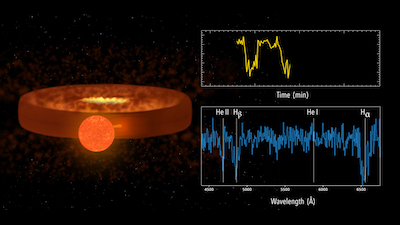Swift J1357.2-0933 is a black hole X-ray binary which shows transient behaviour, alternating long periods of quiescence with short (weeks long) and violent outbursts. These episodes are triggered by a sudden increase of mass accretion onto the black hole. The system was observed to go into outburst in 2017: the first such event since the outburst which led to its discovery in 2011. In a paper published recently in Monthly Notices of the Royal Astronomical Society, Jimenez-Ibarra et al. report high time resolution follow-up of the 2017 outburst.
In the paper, RISE light curves were combined with spectroscopy from the OSIRIS instrument on the 10.4m Gran Telescopio Canarias. The light curves show a series of dips up to 0.5 magnitudes deep and lasting around 2 minutes. The recurrence time of these dips gradually increases as the outburst evolves. Similar events were observed during the 2011 outburst. Spectra obtained during the dips show broad and blue shifted Balmer and He II absorption lines. The interpretation is that the dips are formed in a dense and clumpy outflow, produced near the disc equatorial plane and seen at high inclination.
The authors conclude that the detection of dips in Swift J1357.2-0933 may be favoured by its high orbital inclination (i.e. near edge-on geometry), and as such the clumpy equatorial wind might not be a peculiarity of this particular system but, rather a common phenomenon of accreting stellar-mass black holes in outburst. The study shows the power of combining simultaneous or quasi-simultaneous high time resolution photometric and spectroscopic observations, and is an example of the type of observing campaign which could be pursued entirely robotically when the 4-metre New Robotic Telescope joins the LT at the Observatorio del Roque de los Muchachos in the middle of the next decade.
The full paper can be found here: https://arxiv.org/pdf/1908.00356.pdf



